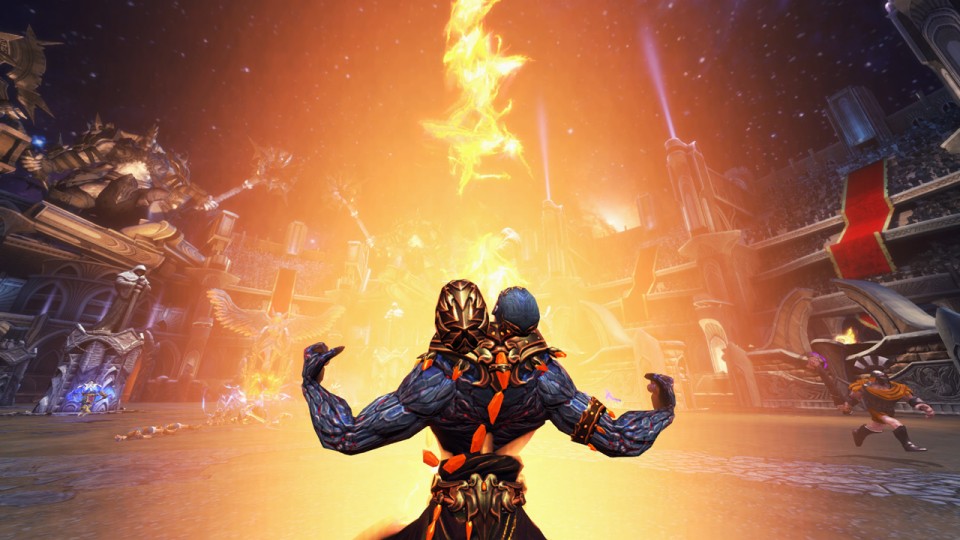Ever since League of Legends exploded a few years back, everyone has wanted to jump on the multiplayer online battle arena (MOBA) bandwagon and get a slice of that eSports money. Some titles – like Dota 2 – carved out their own niche, and are doing well for themselves. Others – like Heroes of Newerth – joined the rather growing landfill of League of Legends-wannabes.
So where does Smite fit in? Thankfully, the developers at Hi-Rez Studios put their own presentational spin on the rapidly bloating genre, which helps differentiate it from its isometric, top-down cousins. Mix this with gameplay hooks that have more in common with first-person shooters than typical MOBAs, and Smite manages to elevate itself amongst the competition. Unfortunately, some muddled tutorial elements and UI problems on the PlayStation 4 version stop the game from being a smooth entry point to those new to the genre.
The broad strokes of Smite are similar to its MOBA siblings. Two teams of five select heroes from a large roster, and face off in a three-laned arena. Running down those lanes are creeps, which spawn periodically from bases, and clash in the middle. By defeating creeps and heroes, you can take down towers (basically high-damage turrets) in those lanes, and push through to the enemy’s base – winning the game.
Smite shakes up the formula here in a number of ways. It adds several PvE elements to the mix, which helps make matches enjoyably chaotic – namely through the use of Phoenixes and Titans.
In most MOBAs there are structures called a barracks – take these down, and your team will start spawning stronger creeps. Smite presents these in the form of Phoenixes: a mix between a tower, and an A.I. controlled enemy. As you push down a lane, you’ll have to take the flying phoenix down in an almost MMO-styled battle. This is also pushed to its extreme with Titans: to win the game, you’ll have to break into the enemy base, and take down this particularly hard boss, all while fighting off other players.
The other differentiator is its camera angle, and aiming mechanics. Smite takes place entirely from the third-person perspective. Abilities and skill-shots are controlled through aiming a reticule. This is also extended to regular attacks – if you whiff a ranged shot, it won’t magically veer towards its target like in League or Dota. Fights almost start to take on a Quake-like vibe, as players will juke left-and-right and snake around to try and avoid projectiles.
To accommodate the change in camera angle and faster, more hectic gameplay, item selection has been streamlined. There are very few usable items in Smite, with the vast majority providing passive benefits like life-steal or armour penetration. The exception to these come in the form of relics: items with long cooldowns, that provide benefits that – on the outset – seem insignificant.
While being able to teleport around the map seems immediately useful, relics like Shell – which reduce the damage you take by 15% for 5 seconds – are a little harder to read in their usefulness. Only MOBA stalwarts who understand the concepts of diving – that is, running at an enemy that is under the protection of their tower – will really glean their full worth.
Indeed, that’s where Smite stumbles, as most MOBAs often do. Apart from the rather bare-bones beginner tutorials – which explain in the broadest terms how to play the game – Smite doesn’t really offer any good entry point for genre first-timers.
They explain how to use your items, or the damage buffs that some enemy camps give, but they don’t explain why any of these things are useful, or worth knowing. You need items. Why? Because there are items. You need to kill these jungle creeps. Why? Because they are there. You should pick a relic. Why? Because you need one. This isn’t a total admonishment of Hi-Rez’s efforts: the MOBA genre is inherently muddled and complex in its mechanics – probably the result of its hacked together, Warcraft 3 modded roots.
The game is also fairly inconsistent with the scale of its UI elements. On a PC monitor, its fine to have small text – your eyeballs are practically glued to the screen anyway. But on a 46” TV I should never have to squint at tooltips – which is something I found myself doing more often than I’d like. This is particularly confusing, given that the text for things like ability descriptions is enormous.
Smite is a solid take on the MOBA genre, with a diverse roster of characters to choose from. It’s unique control method and third-person camera lend a level of immediacy to the action previously not seen in the genre. While the tutorials could see some work, and the tooltip text and other UI elements of the PlayStation 4 version are inconsistent in their size, this doesn’t detract from the game’s solid foundation.


